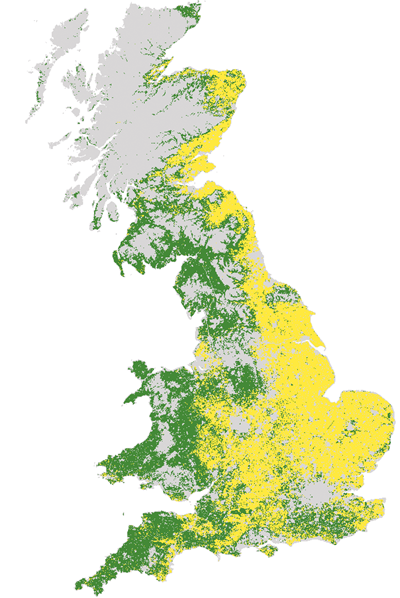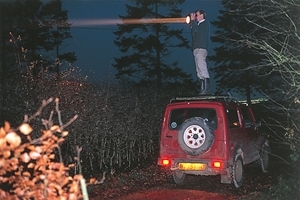The brown hare was one of the first animals to be considered in the Biodiversity Action Plan (BAP) programme. It was chosen, not because it was rare, endangered or under any kind of threat, but because it was once very common, was widespread and had declined significantly during the post-War period. It has been estimated that numbers have dropped by about 75% since the War, a pattern that is also typical of many other European countries. A survey suggested that wintering numbers in Britain may be around 800,000. The BAP proposed that measures should be taken to improve numbers so that our countryside should support at least 2 million animals in winter.

Brown hare habitat in Britain. The yellow area is optimal habitat with a high proportion of
arable farmland. Green is less optimal ground where livestock rearing outweighs arable
farming in importance. Grey areas are unsuited to brown hares for a variety of
reasons. (From CEH Land Cover and OS Geographic reference maps).
Analysis shows that there is plenty of suitable farmland for hares. However, farm mechanisation and modern crop husbandry has reduced hare breeding success and increased the mortality of leverets and adults alike.
Environmental Stewardship and the Campaign for the Farmed Environment
There are a wide range of options now available within Environmental Stewardship schemes to help the brown hare. Even if you decide not to enter either of these government-funded schemes, you can choose many ‘unpaid, voluntary’ options within the Campaign for the Farmed Environment (CFE).
How many hares on the farm?
 Many hares pass unnoticed, and on farms where they are present farmers may not realise just how many they have. Hares are nocturnal for most of the autumn and winter, so most that are seen will have been disturbed.
Many hares pass unnoticed, and on farms where they are present farmers may not realise just how many they have. Hares are nocturnal for most of the autumn and winter, so most that are seen will have been disturbed.
The best way to assess numbers is by spotlight count. At night hares are active and their eye-shine in a spotlight beam makes them visible. After dark in winter and using a pair of binoculars (7x50) aligned with the spotlight, each field can be scanned for hares. By knowing the area that can be seen with the spotlight in each field, it is straightforward to calculate the number of hares across the whole farm. Anything above 40 hares per 100 hectares (250 acres) is a high density.